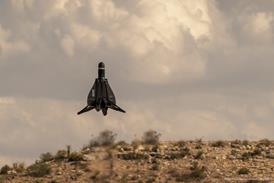Parker Aerospace is pioneering new trends and approaches thanks to technology being developed elsewhere in its diverse parent group, says technology VP Mark Cazja.
Parker Aerospace is not just an aerospace company - and that is one of its strengths. As part of Parker Hannifin, a group with multiple divisions across various industries, Parker Aerospace leverages advances from a variety of markets and applies them as breakthroughs in the aviation industry.
Parker Aerospace’s diverse R&D efforts are all geared toward addressing specific needs voiced by the aviation industry. Some of the latest developments include electric-powered aircraft, lightweight composite aircraft, and high temperature electronics.
“One of the trends we are seeing in the marketplace is the electric aircraft,” says Mark Czaja, Parker Aerospace group vice president of technology and innovation. “The engine not only provides propulsion but also serves as the power plant for the aircraft, running a generator that powers the electrical system. We are seeing a trend in the industry, however, where rather than pulling off electrical, mechanical and pneumatic energy, more and more of the systems will become electrically driven. So some of the losses associated with running these various systems are eliminated.”
 |
|---|
Czaja points out that the green initiative is part of the motivation to move to an electric aircraft, making the airplane more efficient to attain improved fuel economy and longer range. “All of our customers are looking for more efficient ‘greener’ aircraft,” he says. “In the last several years, one of the drivers for us in aerospace has been to provide more efficient operating systems.”
Parker applies green concepts to aviation propulsion and power generation, resulting in low emissions and cleaner-burning engines. The company is pioneering atomization technology for efficiently burning alternative fuels, and leading the way for H2/Syngas.
Parker’s Macrospray spider and single-point nozzles and manifolds provide water-injection applications, including turbine inlet air cooling, with lower installed and life-cycle costs, higher sustained engine performance, and improved fuel flow, atomisation, and placement. All result in reduced emissions and fuel consumption footprints for aircraft.
Another green initiative, which also results in a more efficient airplane, is the development of high-strength yet lightweight composites and smart materials to replace what would traditionally be steel or aluminum parts. New Parker technologies including elastomer conductive seals, wing panel EMI gaskets, and compression- and injection-molded valves and housings are making products that are lighter, stronger, conductive, and corrosion-resistant for highly efficient aircraft.
Parker’s hollow fibre membrane technology also produces nitrogen-enriched air to keep aircraft fuel tanks safe, food fresh, and vehicles more fuel efficient, while reducing volume and weight for all filtration applications.
In addition at Farnborough, Parker is showcasing cutting-edge development of fuel cells, another emerging technology. Parker expects that aircraft of the future may replace currently used ram air turbine starters with fuel cells for backup emergency power systems. Parker is currently partnering with several US universities to develop fuel cells for a variety of applications.
 |
|---|
One of Parker’s strengths is sharing technology between different divisions, finding new ways to apply technologies from one industry to another. “When we get together and share technology, the cumulative effect is very exciting,” Czaja says.
One example is inerting systems designed to introduce hydrogen rich air to the fuel tanks on the airplane. Parker Aerospace collaborated with Parker Hannifin’s filtration division to optimize a filtration system that enables the separation of oxygen and hydrogen content from the air.
Fibreoptics is another area where Parker has made progress, developing the use of the technology for data transmission and powering onboard computers. Parker is demonstrating fibreoptics in a cabin video monitoring system on display at Farnborough. The system uses fibreoptic ethernet for reliability and data integrity.
Fibreoptic cable provides more bandwidth, and is much lighter in weight than copper wire,” Czaja says. “Fibreoptics also offers electromagnetic interference (EMI) immunity and protection from lightning. Today, copper wires need to be shielded so they are not susceptible to lightning and EMI. Fibreoptics, on the other hand, is intrinsically safe.”
“We have been fortunate in winning a lot of new business,” Czaja says. “Recent wins have been for systems developments as opposed to components, and that is an area of focus for us in the future.”
“We can provide component solutions if that is what our customers need,” he continues, “but a general trend we are seeing on both the commercial and military side of the business is customers looking for us to take a larger role in systems or sub-systems development - not only providing our components but integrating them into a larger system. Our goal is to become a systems partner to our customers.”
Czaja believes development at the systems level makes Parker better positioned to provide value solutions for the next generation of aircraft. Although Parker’s systems cannot simply be reused for new aircraft models, the company has developed fundamental building blocks which can be repositioned in multiple systems to meet specific customer needs. This modular approach to development enables the company to develop varied systems with a much shorter cycle time.
“Our goal is to continue to reduce cycle time,” Czaja says. “But we also try to ensure that what comes out of the development cycle is mature and robust. It is not acceptable to find an issue with performance as the aircraft enters service.”
Parker’s innovation leadership can be seen on its stand at Farnborough. A new display features 18 technologies in the areas of environment, material sciences, and energy for use in future and current aerospace and industrial applications.
“We have some challenges as an industry but we have also seen some tremendous growth,” Czaja concludes. “This is a great time to be part of aerospace. Aviation is constantly changing and evolving, and our display of emerging technologies at Farnborough shows how Parker is anticipating the future of aviation.”
Source: Flight International























